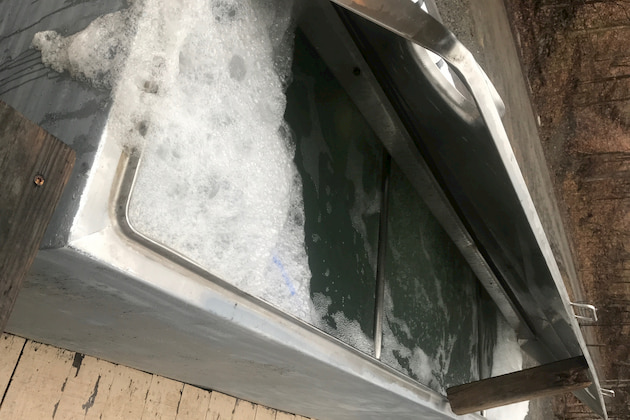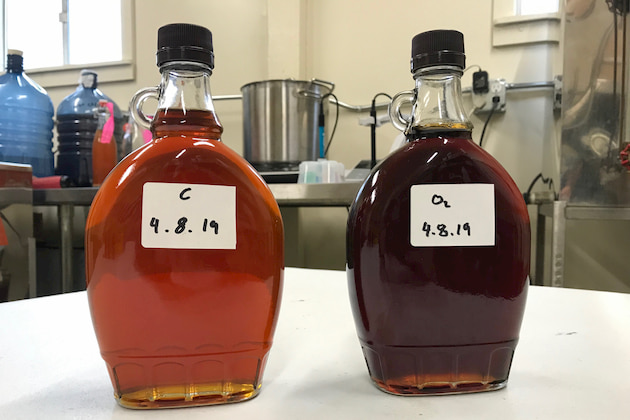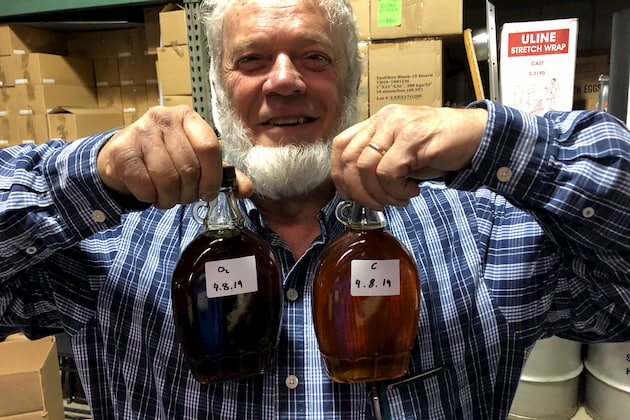Cornell Corner
Get it bubbling
Dissolved oxygen improves syrup quality
By AARON WIGHTMAN, CORNELL MAPLE PROGRAM EXTENSION ASSOCIATE | JULY 7, 2019
VAN ETTEN, N.Y.—Dissolved oxygen levels have a significant impact on syrup grade and flavor, especially in late-season sap.
This season, we found that boosting oxygen levels in sap with a bubbler makes darker syrup with a stronger maple flavor.
In late season saps, the flavor improvement due to bubbler-aeration was significant enough to improve an off-flavored syrup to a dark, table-grade syrup.
Many factors affect the grade and flavor of maple syrup.
One of the lesser known variables impacting syrup quality is the level of dissolved oxygen in sap.
Dissolved oxygen (DO) is simply the amount of gaseous oxygen dissolved into sap through diffusion from the surrounding air or through mixing of sap as it is splashed and agitated at different points in the collection system.
We found that DO levels strongly influence microbial activity, including the bacteria and yeast populations found in maple sap.
As a result, changes in DO levels translate into changes in sap chemistry that can alter the flavor and grade of finished syrup.
Two lines of inquiry regarding the impact of dissolved oxygen on syrup flavor and quality were investigated by the Cornell Maple Program during the 2019 sugaring season.
The first aimed to identify trends in dissolved oxygen levels in sap, while the second studied the impact of dissolved oxygen levels on finished syrup.
Multiple daily measurements of percent dissolved oxygen (DO) were taken from each sap storage tank in the Arnot Research Sugarbush in Ithaca, N.Y. throughout the season.
The samples revealed a wide range of values for sap DO from 1.1 percent to 92.4 percent and an inverse relationship between sap DO and storage time.
Also, because vacuum pumps remove air from tubing systems, sap DO levels decrease as vacuum levels in the collection system increase.
In general, we found that sap emerges from the vacuum collection system with DO levels in the range of 20 percent to 30 percent.
Agitation from the releaser or transfer pump process increases dissolved oxygen levels to as high as 90 percent.
But as the sap is left undisturbed in storage conditions, dissolved oxygen levels steadily fall.
This effect is more pronounced later in the season, pointing to elevated microbial populations consuming oxygen in the process of respiration.
DO levels in storage tanks often decrease to the point where anaerobic activity is possible.
Anaerobic microbial activity is linked to the production of off-flavors in maple syrup.
Therefore, prolonged storage at low dissolved oxygen levels has the potential to adversely impact syrup flavors.
To measure the impact of DO levels on flavor, trials were conducted comparing the flavor of syrup made from sap with artificially enhanced dissolved oxygen levels to syrup produced from control samples held in typical sap storage conditions.
In this study, a batch of fresh sap was divided into two separate storage tanks.
One tank was aerated using bubblers and an air compressor for 12 hours, while the control was held undisturbed simulating long term sap storage conditions in a sugaring operation.
For each trial, the control sample dropped to 1 percent to 2 percent DO saturation over the 12 hour holding time, while the bubbler-aerated sample was maintained at >75 percent DO.
The samples were then concentrated through reverse osmosis and evaporated using identical cook temperature and time on either an induction cooktop or propane stove.
The finished syrups were then graded and evaluated for flavor in a blind taste test.
In each trial the aerated syrup finished to a noticeably darker grade.
This is most likely due to elevated levels of aerobic microbial activity breaking down more sucrose into invert sugars which caramelize more readily during evaporation.
In taste tests all participants identified the aerated sample as having stronger, more favorable flavor than the non-bubblized control sample.
Although more work is needed to develop guidelines for dissolved oxygen management, the results of this study show that DO is an important variable that can be manipulated to control product quality.


































